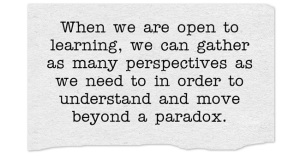
By Linda Fisher Thornton
What is a Paradox?
“A paradox is a statement that contradicts itself, or that must be both true and untrue at the same time.” —Literaryterms.net. Just like the many facets of a cut gem, there are multiple dimensions to complex issues and problems. When we encounter a paradox, we need to step back to get a broader view of the various facets. Each facet reflects one particular element of the issue.
Understanding paradox and how two things that appear to be opposites can both be true helps us understand the trickier facets of ethics. When we reach what seems like a contradiction, we have reached a signal that we need to broaden our thinking until we understand how multiple perspectives can all be true.
“In recent years, leaders have been encouraged to have emotional intelligence and then more recently to have learning agility (or grit, resilience, growth mindset, perseverance). In our research, navigating paradox has become the next wave in the evolution of leadership effectiveness.”
Dave Ulrich, Professor at the Ross School of Business, University of Michigan, and a partner at the RBL Group
Let’s take a look at a simple paradox: “We are all different AND we are all the same.” The truth is not found in one OR the other of these statements. It’s found in embracing both.
We are all different and We are all the same.
We are all different in terms of personality, thoughts, background, and experiences. We have individual fingerprints. We see the world from our unique frame of reference.
We are all the same in many ways as well – we are human, we share a planet, we have emotions and challenges, we learn and grow, and we have hopes and dreams. Even with a high degree of respect for individual expression, there are many traits we share.
Complexity and Paradox
When we see a paradox, there’s often a piece of information that we don’t have that would explain it. If we latch on to one side or the other of the contradiction as “true,” we may fall into the kind of narrow thinking that contributes to conflict and confrontation. A cut gem is brilliant because of the light that reflects from the many facets of the stone. If we fixate on one or two flat surfaces of the gem, our view lacks dimension, and any decisions we make based on a flat view will be misinformed in a 10-dimensional world.
By changing our perspective or the context, we can begin to see that multiple interpretations of something can all be true.
When we look too closely at a part of any issue, we can miss the greater meaning of the whole. For example, some people may argue that ethics is just about character, respect for others, or caring for those in need. Arguing any one of those positions takes our eye off the whole picture, and in that bigger picture, character, respect, and care for others are all important aspects of ethics.
Learning Beyond the Paradox

When we are open to learning, we can gather as many perspectives as we need to in order to understand and move beyond a paradox. Often, this process will take us out of our comfort zones and force us to think in new ways. What is an unresolved paradox? It’s a clear signal that the perspective we’re using to understand the problem is too narrow.
Leading beyond paradox requires leading with an open mind and being willing to adapt our perspective based on new information. That helps in solving problems and builds credibility with those we lead and serve.
It seems as though the two statements in the “We are all different AND We are all the same” example above should be either/or (either we are all the same or we are all different), but when we are open to looking for the many facets of humanity we see that that both can be true at the same time. Understanding how to move beyond the paradox helps us avoid oversimplifying a complex issue which is necessary for making ethical choices.
The way we think has ethical implications. Using narrow or one-dimensional thinking can cause us to make decisions that harm or have other unintended consequences.
Leading effectively and ethically in the midst of complexity requires becoming comfortable with paradoxical situations and learning to navigate through them. Don’t argue that an issue has ONE facet, when others can see that it has many. When you reach a paradox, learn through it by changing your perspective, gathering more information, and getting a broader view.

Unleash the Positive Power of Ethical Leadership
© 2009-2024 Leading in Context LLC

Lovely post! Thanks.
Jonathan
Jonathan B. Wight, Ph.D.
Professor of Economics
Robins School of Business, Room Q369
102 UR Drive, University of Richmond, VA 23173
804.289.8570
https://facultystaff.richmond.edu/~jwight/
LikeLiked by 1 person